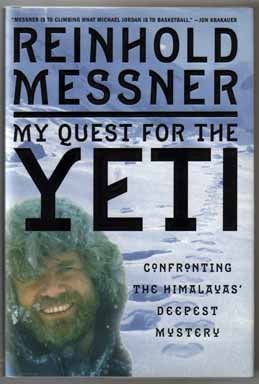Synopsis
One of the world's great mountain climbers returns to the Himalayan Mountains, where he explores the mystery of Yeti, or "abominable snowman". Original.
Reviews
The first human to climb Everest without bottled oxygen, and the first to summit the world's 14 highest peaks, Messner is a legend in mountaineering circles. How appropriate, then, that he should take on another legend associated with mountains--the yeti, aka the Abominable Snowman. Messner's quest to uncover the truth behind the legend begins in July 1986, in Tibet, where, at night, deep in that country's eastern wilderness, he encounters something: "the creature towered menacingly, its face a gray shadow, its body a black outline. Covered with hair, it stood upright on two short legs and had powerful arms." On and off for the next 11 years, Messner undertakes expeditions through Tibet and Bhutan in search of that creature. In time, he learns to distinguish between the myth of the yeti ("a collective term for all the monsters of the Himalayas, real or imagined") and the animal on which the myth is based, which he realizes is known throughout the region as the chemo or dremo, and which he concludes is a type of brown bear (Ursus arctus), which he observes several times. That conclusion will disappoint readers looking for evidence of a missing link or humanoid bigfoot, but even so there's plenty of high adventure in the book, as Messner treks across snowy wastelands, gets lost, gets arrested, sleeps in smoky tents and under the stars--and describes both the history of yeti research and the ongoing eradication of Tibetan culture at the hands of Chinese invaders. An engaging blend of travelogue and cryptozoological inquiry, this book will make a great campfire read.
Copyright 2000 Reed Business Information, Inc.
Messner is an accomplished Austrian mountaineer and the author of several books about his experiences. In 1986, while in Tibet, he thought he may have encountered a yeti, also called the abominable snowman. Finding more substance in folklore and mythology than reality, Messner chronicles his further investigations while providing a good overview of the efforts of others over the years at documenting the existence of such a humanlike creature. His account will not satisfy those whose minds are already made up on either side of the issue, and this will not be the last book on the topic. It is, nevertheless, a reasonable account of a subject that generates continuing interest and polarity among public library users. A more thorough investigation of the topic is Daniel Taylor-Ides's Something Hidden Behind the Ranges: A Himalayan Quest (Mercury House, 1995), which provides more convincing background information that such creatures do not exist. Nevertheless, Messner's book is a solid second choice.
-Harold M. Otness, Southern Oregon Univ. Lib., Ashland
Copyright 2000 Reed Business Information, Inc.
"About this title" may belong to another edition of this title.
